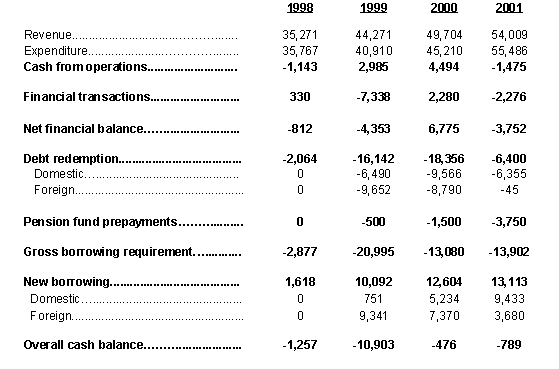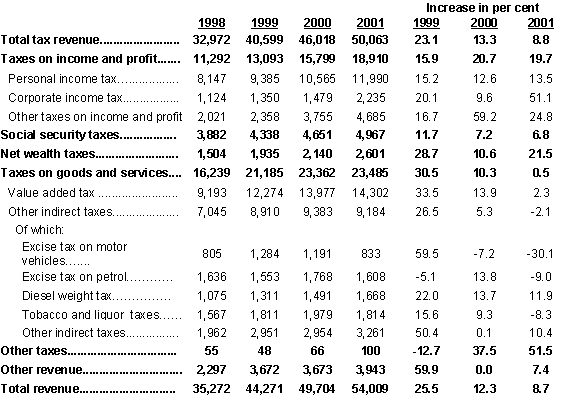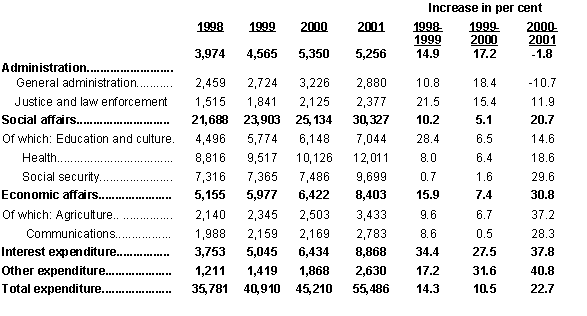Treasury finances January - March 2001. Report date April 25. 2001.
Treasury finances, January-March 2001
Report date April 25, 2001
This report is available in PDF-form (161K)
Figures for Treasury finances in the first quarter of 2001 are now available. They are on a cash basis and therefore not comparable to the Treasury accounts or the fiscal budget, both of which are presented on an accruals basis.
Summary
The cash balance from operations amounted to a 1.5 billion krónur deficit in the first quarter of this year, compared to a surplus of 4.5 billion krónur last year. This result is around 800 million krónur above budget projections. Both revenues and expenditures exceed projections, revenues by 1.7 billion krónur and expenditures by 0.9 billion.
Treasury finances in January-March
(Millions of krónur, cash basis)

(Millions of krónur, cash basis)

Revenues are 4.3 billion higher than in the same period last year that is primarily caused by a 4.1 billion krónur increase in taxes on wages and profits. Expenditures are 10.3 billion higher than last year, of which 2/3 are due to special circumstances. Interest payments increase by 2.6 billion krónur; special payments to the disabled amount to 1.3 billion krónur; 1.1 billion is due to a contribution to improve the cash flow status of the Social Security Administration because of health insurance; government purchase of farm production quotas amount to 0.8 billion and a special increase in contributions to the Municipal Equalisation Fund amounts to 0.7 billion.
The net financial deficit amounted to 3.8 billion krónur, 0.5 billion above projections, but about 10 billion less than a year ago. This result is due to the increase in expenditures mentioned above in addition to the fact that last year the Treasury received a one-time payment of 5.5 billion for the sales of shares in the two state-owned commercial banks. These sales actually took place late in 1999 with payment in early 2000.
A total of 3.8 billion krónur were paid to the Government Employees Pension Fund in the first quarter of this year. This is being done to reduce the future commitments of the Treasury to the Fund. A total of 15 billion is allocated for this purpose in the 2001 fiscal budget.
The overall cash deficit was 800 million krónur for the first quarter of the year, compared to a 500 million krónur deficit a year ago.
Revenue
Total revenue of the Treasury amounted to 54 billion krónur in the first quarter of the year, close to 1.7 billion in excess of projections. Revenue exceeded the level of last year by 8.7 per cent, a considerably smaller increase than in the two preceding years. The development of tax revenue is similar, showing clear signs of a slowdown in the economy. Although taxes on income and profit are still increasing at a good pace, by close to 20 per cent between the years, the increase stems mainly from proceeds from the corporate income tax and the capital income tax. Revenue from the personal income tax rises considerably less, or by 13.5 per cent. This increase exceeds the one last year, which is interesting as the income tax rate was lowered by 0.33 per cent at the beginning of this year. This is due to the fact that last years pay settlements on the private market did not take effect until the second quarter of last year.
Net wealth taxes exceed the level of last year by 460 million krónur, or 21.5 per cent. This is primarily due to an increase in the registered market value of real property, but revenues from stamp duty and special transfer taxes increased by 130 million krónur.
Treasury revenue in January-March
(Millions of krónur, cash basis)

(Millions of krónur, cash basis)

The slowdown in the economy is also clearly reflected in the development of indirect taxes. Indirect taxes increased by more than a third between 1998 and 1999 and by 10.3 per cent between 1999 and 2000; the pace has slowed down to 0.5 per cent in the first quarter of this year. This development actually reflects a slight contraction in real terms, as inflation has been close to 4 per cent. This is partly explained by a decline in vehicle imports by around 30 per cent in the first quarter of this year from last year's level which in turn is mirrored in reduced excise revenue on imported vehicles by about a third between the same periods.
The value-added tax, which is the single largest revenue item, has only yielded a 2.3 per cent increase so far, which gives a strong indication of a decelerating economic activity.
Expenditure
Total expenditure of the Treasury amounted to 55.5 billion krónur in the first quarter of the year, an increase of 10.3 billion from the previous year. There of 2.6 billions can be attributed to higher interest expenditures. Expenditure exceeded the cash flow projection by 0.9 billion, which in part is explained by the fact that payments may diverge from projections for such a short period.
Treasury expenditure in January-March
(Millions of krónur, cash basis)

(Millions of krónur, cash basis)

Administrative expenditures, which include the Presidency, the Cabinet, Althingi, the courts and law enforcement, are approximately unchanged from the previous year. The slight decrease in administrative expenditures is partly due to a lower cost of real estate management, by 100 million krónur.
More than half of total expenditures in the first quarter went to social affairs including education, culture, health and social security. Expenditures in this category rise by 5.2 billion krónur between the years, the increase being distributed amongst all expenditures.
Increase in payments to education and culture by 900 million, can partly be explained by an increase in expenditures on secondary schools, amounting to 450 million krónur due to additional overtime following the secondary school teachers' strike last year. In addition some rescheduling of payments took place. Payments to the University of Iceland increased by 130 million and to the Student Loan Fund by 100 million. Health outlays increased by 1.9 billion, 1 billion of which to improve the cash flow status of the Social Security Administration, which in turn overestimates the real annual changes in expenditures. Expenditures to nursing homes increased by 800 million. This is partly due to wage increases.
Expenditures on social security increase by 2.2 billion krónur, close to 30 per cent between the years. This is primarily attributed to an increase in payments to the disabled, in accordance with a Supreme Court ruling, by 1.3 billion that represents a retroactive payment for four years. Furthermore, pension payments increase in accordance with the same ruling.
Unemployment compensation is nearly unchanged from the previous year since the unemployment rate has decreased between the years, from 1.5 per cent this year against 1.8 per cent last year. The cost impact of the newly created Parental Leave Fund in the first quarter of the year amounts to 250 million krónur.
Expenditures on economic affairs increase by close to 2 billion or 31 per cent, primarily due to government purchases of farm production quotas, an outlay of 780 million krónur in January. Expenditures on communications increased by 550 million and contributions to the Institute of Regional Development by 300 million krónur between the years.
Interest expenditures increased by 38 per cent or by close to 2.5 billion krónur, 1.8 billion of which is due to the redemption of a large government bond issue and 200 million krónur due to short-term credit from abroad.
Other expenditures increase by 760 million krónur between the years, primarily due to a special increase in contribution to the Municipal Equalisation Fund.
Capital transactions
The outflow on financial transactions amounted to 2.3 billion in the first quarter of this year as against an inflow of 2.3 billion last year. The difference is mostly explained by an in-payment of 5.5 billion early in 2000 due to the above-mentioned sales of shares in state-owned commercial banks.
Repayments of Treasury debt amounted to 6.4 billion krónur, nearly all due to the redemption of domestic government bonds. A large issue from 1990 matured in February and the redemption amounted to 8.4 billion krónur, of which 4.6 billion were repayments of principal, the remainder being accumulated interest..
Furthermore, two government bonds issues were redeemed before maturity at an auction for 1.9 billion of market value, of which 1.5 billion were repayments. Auctions of this kind are directed toward government bond issues that lack liquidity in the secondary market.
The Treasury remitted 3,750 million krónur to the Government Employees Pension Fund, as noted above, as against 1,500 million in the same period a year ago.
Treasury borrowing amounted to 13.1 billion krónur, half of which was in Treasury bills which increased the stock of bills by 6.8 billion. In addition, new government bonds with a 6-year maturity were sold for close to 2.5 billion krónur.
Finally, 3.7 billion were drawn on a foreign revolving credit in order to meet temporary cash needs.
